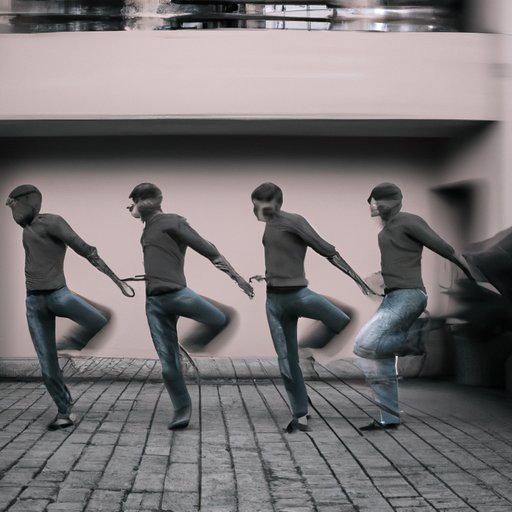Introduction
Balance is an important concept in photography – it’s the foundation upon which great photos are built. Balance involves creating equilibrium between elements in a photograph to create a sense of harmony and visual appeal. It’s often used to evoke strong emotions or tell a story. But what exactly is balance in photography, and how can you achieve it? In this article, we’ll explore the principles of balance in photography and provide tips and techniques for achieving balance when taking photos.

Exploring the Principles of Balance in Photography
Balance in photography is all about creating equilibrium between elements in a photo. This can be achieved through a variety of techniques, including symmetry and asymmetry, color theory, composition, and light. Let’s take a closer look at each of these principles.
Symmetry and Asymmetry
Symmetry is one of the most powerful tools for creating balance in photography. Symmetrical compositions feature two identical halves that reflect each other, creating a sense of balance and harmony. On the other hand, asymmetrical compositions involve elements that don’t match up, creating a feeling of tension and unease. Both symmetry and asymmetry can be used to create interesting and effective photographs.
Color Theory
Color theory is also an important component of balance in photography. Color can be used to draw attention to certain elements in a photo, while also creating a sense of harmony and balance. For example, contrasting colors can be used to create visual interest, while complementary colors can be used to create a sense of balance. By understanding the basics of color theory, you can use color to create balanced and visually appealing photographs.
Composition
Composition is another key principle of balance in photography. Composition involves arranging elements within a frame to create an aesthetically pleasing image. By using the rule of thirds, leading lines, and other compositional techniques, you can create a sense of balance and harmony in your photos.
Light
Light is another essential element of balance in photography. The use of light can help create a sense of drama and atmosphere in a photograph, as well as highlighting certain elements and creating a sense of balance. Natural light is often the best choice for achieving balance in photography, but you can also use artificial light to create interesting and unique effects.
Using Color, Composition and Light to Achieve Balance in Photos
Now that we’ve explored the principles of balance in photography, let’s look at how to use color, composition and light to achieve balance in photos.
Using Color to Create Balance
Color can be used to create balance in photos by emphasizing certain elements and drawing attention away from others. Contrasting colors can be used to create visual interest and draw the eye, while complementary colors can be used to create a sense of harmony and balance. You can also use color to create a sense of depth and dimension in a photo.
Composing for Balance
Composition plays an important role in creating balance in photos. By using the rule of thirds, leading lines, and other compositional techniques, you can create a sense of balance and harmony in your photos. You can also use framing to create a sense of balance, as well as focusing on negative space to create a sense of emptiness and stillness.
Harnessing the Power of Light
Light is a powerful tool for creating balance in photography. Natural light is often the best choice for achieving balance in photography, but you can also use artificial light to create interesting and unique effects. By using light to emphasize certain elements and draw attention away from others, you can create a sense of balance and harmony in your photos.
Tips and Techniques for Achieving Balance When Taking Photos
Now that we’ve explored the principles of balance in photography, let’s look at some tips and techniques for achieving balance when taking photos.
Utilizing the Rule of Thirds
The rule of thirds is one of the most popular compositional techniques for achieving balance in photos. The rule of thirds involves dividing an image into three sections horizontally and vertically, with the four points where the lines intersect forming the focal points of the image. By placing the subject of the photo at one of these points, you can create a sense of balance and harmony in the photo.
Framing Your Shots
Framing is another technique for creating balance in photos. By framing your shots with objects such as trees, buildings, or people, you can create a sense of balance and harmony in the photo. Framing can also help to draw attention to the subject of the photo, as well as adding depth and dimension to the image.
Filling the Frame
Filling the frame is another effective technique for creating balance in photos. By filling the frame with the subject of the photo, you can create a sense of balance and harmony in the photo. Filling the frame can also help to draw attention to the subject of the photo, as well as adding depth and dimension to the image.

How to Create Dynamic Balance in Your Photographs
Dynamic balance is a type of balance that involves creating tension between elements in a photograph to create movement or energy. Dynamic balance is often used to evoke strong emotions or tell a story. Here are some tips and techniques for creating dynamic balance in your photos.
Playing with Contrast
One way to create dynamic balance in your photos is by playing with contrast. By contrasting elements such as light and dark, warm and cool colors, or sharp and soft edges, you can create a sense of tension and movement in your photos. This can help to evoke strong emotions and draw attention to certain elements in the photo.
Employing Negative Space
Negative space is another powerful tool for creating dynamic balance in photos. By leaving empty areas in a photo, you can create a sense of tension and movement. This can be used to draw attention to certain elements in the photo, as well as creating a sense of balance and harmony.
Introducing Movement
Movement is another way to create dynamic balance in photos. By introducing motion into your photos, you can create a sense of tension and movement. This can be done by capturing subjects in motion, such as birds in flight or running water, or by introducing blur or panning techniques into your photos.

Applying the Rule of Thirds to Achieve Balance in Photos
The rule of thirds is one of the most popular compositional techniques for achieving balance in photos. The rule of thirds involves dividing an image into three sections horizontally and vertically, with the four points where the lines intersect forming the focal points of the image. By placing the subject of the photo at one of these points, you can create a sense of balance and harmony in the photo.
Understanding the Rule of Thirds
The first step in applying the rule of thirds to achieve balance in photos is to understand the concept. The rule of thirds involves dividing an image into three sections horizontally and vertically, with the four points where the lines intersect forming the focal points of the image. Placing the subject of the photo at one of these points will create a sense of balance and harmony in the photo.
Implementing the Rule of Thirds
Once you understand the concept of the rule of thirds, you can start to implement it in your photos. To do this, you need to divide the frame into three sections horizontally and vertically, with the four points where the lines intersect forming the focal points of the image. Then, position the subject of the photo at one of these points to create a sense of balance and harmony in the photo.
Examples of Applying the Rule of Thirds
Here are some examples of how the rule of thirds can be applied to achieve balance in photos:
- Positioning the horizon along the top or bottom third of the frame to create a sense of balance and harmony in a landscape photo.
- Placing the subject of a portrait along one of the vertical lines to create a sense of balance and harmony in the photo.
- Positioning the main subject of the photo along one of the horizontal lines to create a sense of balance and harmony in the photo.
Conclusion
Balance is a fundamental element of good photography. In this article, we’ve explored the principles of balance in photography and provided tips and techniques for achieving balance when taking photos. We’ve looked at the importance of symmetry and asymmetry, color theory, composition, and light in creating balance in photos. We’ve also discussed how to use the rule of thirds to achieve balance in photos. By understanding and applying these principles, you can create balanced and visually appealing photographs.
Summary of Key Points
In conclusion, balance is a fundamental element of good photography. Balance involves creating equilibrium between elements in a photograph to create a sense of harmony and visual appeal. Symmetry and asymmetry, color theory, composition, and light are all important components of balance in photography. You can also use the rule of thirds to achieve balance in photos. By understanding and applying these principles, you can create balanced and visually appealing photographs.
Recap of Benefits of Balance in Photography
By understanding and applying the principles of balance in photography, you can create balanced and visually appealing photographs. Balance can be used to evoke strong emotions or tell a story. It can also help to draw attention to certain elements in a photo and create a sense of harmony and balance. By mastering the principles of balance in photography, you can create stunning and captivating images.
(Note: Is this article not meeting your expectations? Do you have knowledge or insights to share? Unlock new opportunities and expand your reach by joining our authors team. Click Registration to join us and share your expertise with our readers.)
